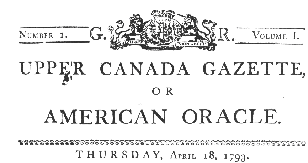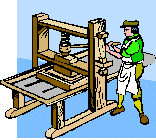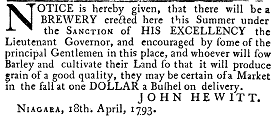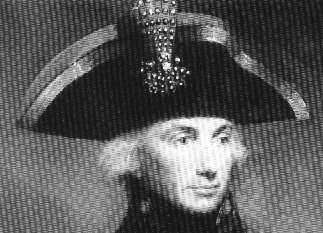
foreword | Historical Narratives | Resources | Links | Contact
ONTARIO'S FIRST NEWSPAPER
History is an artifact.
The paper was named the Upper Canada Gazette, or American Oracle. Its double-barreled designation reflected the newspaper's dual role as both recorder of government acts and attitudes, and purveyor of news and information.
 |
|
Upper Canada Gazette/American Oracle, Vol. 1 No. 1 |
The more things change the more they are the same. Today in China the government directs its country's newspapers to serve as China's "eyes, ears and mouth." Editors are expected to promote government policies and patriotism and to print news that is "healthy and wholesome."
Some two hundred years ago in Upper Canada, Lieutenant-governor John Graves Simcoe assigned a similar role to the province's first newspaper editor. His Excellency "assumed" the editor's good sense and discretion would "induce" him to give preference to information "which is most favourable to the British government" and to feature articles in his paper of a "useful and instructive" nature.
 |
Simcoe emphasized that the Gazette's primary function was to disseminate government matters, such as Simcoe's Speech From the Throne. Only when there was "a dearth of political intelligence" was the paper permitted to provide its readers with details of local and international interest. Its main mandate was to serve as the government's mouthpiece.
Very early on Simcoe recognized the critical importance of a frontier newspaper. Even before he left England to take up his duties in Upper Canada, Simcoe outlined its importance to Henry Dundas. In seventeen essential requirements for the colony, Simcoe listed as number ten: "a printer who might also be postmaster. A government-sponsored newspaper was needed to disseminate information to the inhabitants of his new province. While he was in Montreal, Simcoe sought the services of a printer. The first man to bear the title King's Printer was Louis Roy, a 21 year old native of Quebec. On November 4, 1792, Roy set up shop at Newark and made out his first requisition for supplies and equipment. For his job as printer Roy received a good salary along with free rations and accommodations for himself and his printer's paraphernalia.
 |
Roy's wooden screw press was an English press commonly used in the 18th century and was purchased by Simcoe from Samuel Neilson in Quebec City. The printing process involved inking the typeface by hand, applying the paper to be printed and lowering a lever to exert the necessary pressure. The whole procedure was doubtless awkward and unwieldy, but an experienced printer could produce from forty to fifty copies an hour. Made of sturdy English oak, the press was 74 inches in height and weighed some 800 pounds. This second-hand press was thought to have been brought to Niagara sometime during the summer or autumn of 1792. The press was used until 1813 when it was seriously damaged by the Americans following their capture of York.
Today this very same press is the centre-piece of The Mackenzie Printery and Newspaper Museum in Queenston. This popular tourist attraction is located appropriately in the former home of Upper Canada's most famous publisher, the Little Rebel, William Lyon Mackenzie. It is the only wooden press in Canada and thought to be one of less than ten left in the world.
Louis Roy pledgedIn His Own Words
"To call forth every exertion of which I am master so as to render the paper useful, entertaining and instructive." He was, he said, "highly flattered in becoming the Vehicle of Intelligence in this growing province." He also respectfully informed the Public that "the flattering prospect which he had for an extensive sale for his undertaking enabled him to augment the size originally proposed from A Demy Quarto to a Folio." Commercial printing orders for "letter press printing shall be executed with neatness, dispatch and attention, and on the most reasonable terms." The newspaper was printed on good, sturdy paper which Roy initially purchased from Albany. When Simcoe, who was no supporter of free trade, learned of this, he reprimanded Roy for buying paper in the United States and directed in future that Canadian or English paper be purchased through Montreal.
The semi-official Gazette was a weekly folio of four, two-column pages, each fifteen inches by nine and one-half inches. Its subscription price was $3.00 per annum. Volume 1, Number 1, of the first edition of the Upper Canada Gazette or American Oracle, appeared on Thursday, April 18, 1793. On the front page of the four-page folio was the text of a Speech from the Throne given by King George III on December 13, 1792. Advertisements not exceeding twelve lines were accepted for insertion at the rate of four shillings. The first edition contained a proclamation of His Excellency Lieutenant Governor John Graves Simcoe calling for "the suppression of Vice, Profaneness, and Immorality." It directed all "Peace Officers and Constables" to prosecute to the limit of the law all persons "who shall presume to offend" laws pertaining to the above and to prosecute "all persons who contrary to their duty shall be remiss or negligent in putting the said Laws into execution."
News of Niagara featured on the back page included notes about: (a) American commissioners who were to stop over in town on their way to Sandusky, "for the desirable purpose of establishing a permanent peace with the Indians;" (b) the Legislative Council and House of Assembly were to assemble on the 28th of June; (c) His Majesty's sloop the Caldwell sailed for Kingston; (d) extracts regarding European news indicated that the Duke of Brunswick had commenced a Winter Campaign with apparent success, and that the Hessians had defeated of a party of the French; (e) His Majesty's armed schooner Onondaga in company with the Lady Dorchester, merchantman, arrived in the river after an agreeable passage of 36 hours. It was reported that the weather that winter was remarkably mild, the temperature not dropping below minus nine Fahrenheit. Lake Erie did not freeze over and Lake Ontario saw very little ice.
 |
In an interesting report on a debate in the British House of Lords headed "Parliamentary Intelligence," Upper Canadians learned that British statesmen felt the times were turbulent and "big with danger." Murders were being committed in France at which "humanity shuddered and Nature revolted." Some 9000 Frenchmen had fled from their country and were in England "supported by public bounty." In order to relieve the British taxpayer of this drain on the taxpayers' purse, it was suggested that these aliens be "sent to the western part of Canada." They subsquently were led by the French nobleman de Puisye, who had been forced to flee France after his royalist recruits, who were financed by Britain, had been defeated by the republican forces.
The back page contained a commercial notice announcing the opening of a malt liquor plant in Niagara and inviting farmers to sell him barley.
 |
Despite the best efforts of the publisher, it did not appear that the Gazette was a particularly popular publication for its readership in some parts of the province was rather in short supply. At least that was the opinion of a French visitor to Upper Canada in 1795. The Duke de Rochefoucauld visited the colony and he recorded in his diary that the Gazette "was not taken by a single person in Kingston, but that the Quebec Gazette was taken by two."
Roy was a superior printer, but he got off to a bad start and was censured by Simcoe for failing to print the statutes of the first parliament on time. Roy ascribed the delay to his illness, and promised improved service. While things did get better, Roy did not remain on the job for long. It seems he was worn out by work and distressed by the wilderness. He found the relative isolation difficult to endure. Deciding to find greener pastures, Roy submitted his resignation and left Upper Canada for Montreal in the autumn of 1794. Seeking the excitement of the big city, Roy moved to New York where he found work as foreman of the New Daily Advertiser. In 1799, he died of yellow fever in 1799. His loss was lamented, for his obituary referred to him as "Genuine Patriot and truly honest man of worthy character."
With the departure of Roy, Simcoe took a more intense interest in the Gazette. and was particularly watchful of Roy's replacement, two brothers named Gideon and Silvester Tiffany, who learned their craft in their native United States. When they took up the task as King's Printers in November 1794, they were warned to act "uprightly and industriously" in order to meet with his Excellency's expectations. If they did so, they would be "architects of your own fortunes and the best preservers of your own characters."
Simcoe also suggested thatIn His Own Words
"your own good sense and discretion in a variety of intelligence would induce you to prefer that which is most favourable to the British Government."
It was not long before the Tiffanys decided to expand their efforts and increase their output, and they requested permission to publish a 'Monthly Magazine.' Approval was given, but Silvester was cautioned that publication of the Provincial Statutes was of primary importance, and bluntly reminded that his salary was paid principally for printing the Gazette, which was to be "executed regularly." If government news was sparse and space permitted, Simcoe told Silvester to consult with "gentlemen of knowledge and information" in the community, who would happily assist him to find subjects fit for the paper.
The Gazette contained no editorials, no personals, no poetry, no stories, no births, no deaths, no marriages, no illustrations, and few advertisements. It confined its columns to copies of official documents and was, unfortunately, frustratingly bereft of news of the York. It would have been gratifying for posterity had the publishers of the paper provided accounts of the "short and simple annals" of the town and its inhabitants, but these were deemed of trifling consequence and an unworthy waste of ink and paper. When a local incident was covered details were generally very meagre. Information about elections was likewise regrettably fragmentary and for good reason. In 1800 the editors of the Gazette were severely reprimanded for publishing a comparatively mild letter questioning the political independence of a citizen of some "eminence of station." Thereafter, prudence was the practice and the Gazette was never used as a forum for free discussion of political issues.
The Tiffanys were journalists as well as printers and over time they decided to strike out in a new direction. They had ideas of their own regarding the paper and turned out to be somewhat less ready than Roy to comply with Simcoe's incessant directions regarding publicizing government matters. They determined they would extend their coverage and conflict soon developed between Simcoe and the two Tiffanys.
In defiance of Simcoe's orders to feature official propaganda, the brothers began to publish news regarding the United States, and added insult to injury by featuring much of it on the front page, while the King's speech from the throne and government proclamations were relegated to the back pages in small print. Simcoe fumed at this abominable behaviour and his exasperated indignation was echoed by another angry critic of the Tiffany's infuriating preference for American news, the Chief Justice. Chief Justice John Elmsley complained that he searched the Gazette in vain for any sign of one of Sovereign's speeches, but all he found
In His Own Words"was every trifle relating to the damned States printed in large characters."
 |
Guideon Tiffany terminated his career as Queen's Printer when he attempted to blackmail the colony's Administrator, Peter Russell, and in 1797 he was disqualified by a court conviction from holding any public position. Silvester continued as printer until 1798, when it was reported that the Tiffanys had announced their intention "of setting up a paper for the purpose of disseminating political knowledge." In July 1799 they established the first independent newspaper in Upper Canada, the Canada Constellation. It lasted for one year, after which Gideon gave up the press for the plough and took up farming in Middlesex County. Silvester pressed on and in 1801 he founded another weekly, the Niagara Herald, the last issue of which appeared on 28th of August, 1802, following which Silvester returned to the United States>/p> The Gazette travelled with the government to York, where its first issue was published on October 4th, 1798. It bore the Royal Arms and the initials G.R. on its title page indicating the paper's official nature.
Any foreign news featured was often more like history, for it appeared in print long after the date of the event. On January 5th, 1799 the Gazette headlined the heroic victory of Lord Nelson over the French fleet at the Battle of the Nile - five months after the shooting had ceased. Its delay did not lessen the joy of York residents, who joined in the "general illumination" and marked the celebration of this historic event by burning candles in their windows.
 |
 |
|
Rear Admiral Lord Horatio Nelson |
Publication of the Gazette was interrupted when the press was smashed by American soldiers during their occupation of York in the spring of 1813. The paper finally folded for good when the last Printer to King's Most Excellent Majesty, Richard Watson, died heroically in the great Toronto fire of 7 April, 1849, while attempting to save type from the printing office.
 |
During the course of the paper's publishing history, Upper Canada developed from a province with a sparse population sprinkled along the lake, to one with nearly three quarters of a million inhabitants. While historians lament that the paper failed to furnish more details about the life and times of the people and the period, the Gazette throughout its long history, was an important source of information on the economic and political evolution of Upper Canada.
Copyright © 2013 Website Administrator